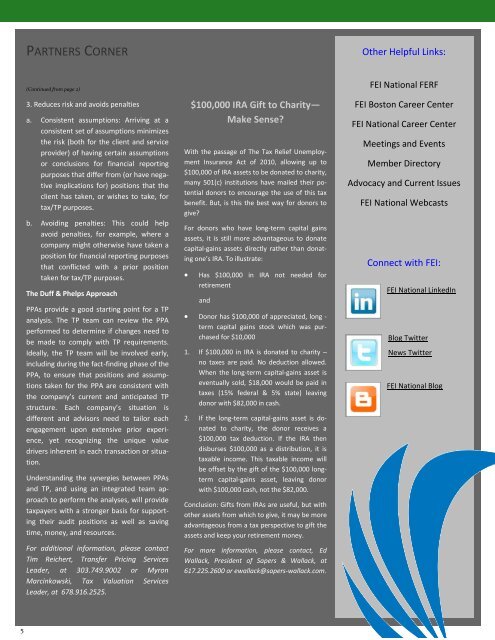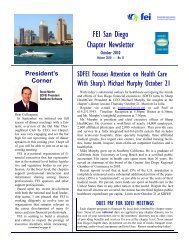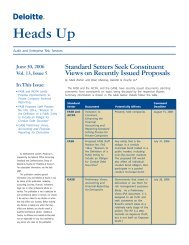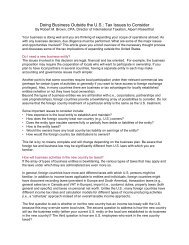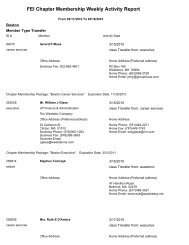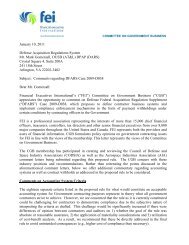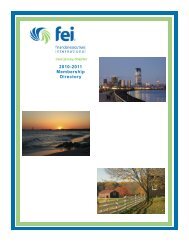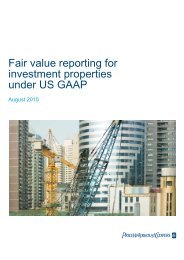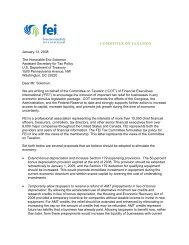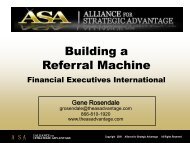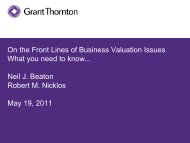April 2011 Newsletter - Financial Executives International
April 2011 Newsletter - Financial Executives International
April 2011 Newsletter - Financial Executives International
Create successful ePaper yourself
Turn your PDF publications into a flip-book with our unique Google optimized e-Paper software.
5<br />
PARTNERS CORNER<br />
(Continued from page 2)<br />
3. Reduces risk and avoids penalties<br />
a. Consistent assumptions: Arriving at a<br />
consistent set of assumptions minimizes<br />
the risk (both for the client and service<br />
provider) of having certain assumptions<br />
or conclusions for financial reporting<br />
purposes that differ from (or have negative<br />
implications for) positions that the<br />
client has taken, or wishes to take, for<br />
tax/TP purposes.<br />
b. Avoiding penalties: This could help<br />
avoid penalties, for example, where a<br />
company might otherwise have taken a<br />
position for financial reporting purposes<br />
that conflicted with a prior position<br />
taken for tax/TP purposes.<br />
The Duff & Phelps Approach<br />
PPAs provide a good starting point for a TP<br />
analysis. The TP team can review the PPA<br />
performed to determine if changes need to<br />
be made to comply with TP requirements.<br />
Ideally, the TP team will be involved early,<br />
including during the fact-finding phase of the<br />
PPA, to ensure that positions and assumptions<br />
taken for the PPA are consistent with<br />
the company’s current and anticipated TP<br />
structure. Each company’s situation is<br />
different and advisors need to tailor each<br />
engagement upon extensive prior experience,<br />
yet recognizing the unique value<br />
drivers inherent in each transaction or situation.<br />
Understanding the synergies between PPAs<br />
and TP, and using an integrated team approach<br />
to perform the analyses, will provide<br />
taxpayers with a stronger basis for supporting<br />
their audit positions as well as saving<br />
time, money, and resources.<br />
For additional information, please contact<br />
Tim Reichert, Transfer Pricing Services<br />
Leader, at 303.749.9002 or Myron<br />
Marcinkowski, Tax Valuation Services<br />
Leader, at 678.916.2525.<br />
$100,000 IRA Gift to Charity—<br />
Make Sense?<br />
With the passage of The Tax Relief Unemployment<br />
Insurance Act of 2010, allowing up to<br />
$100,000 of IRA assets to be donated to charity,<br />
many 501(c) institutions have mailed their potential<br />
donors to encourage the use of this tax<br />
benefit. But, is this the best way for donors to<br />
give?<br />
For donors who have long-term capital gains<br />
assets, it is still more advantageous to donate<br />
capital-gains assets directly rather than donating<br />
one’s IRA. To illustrate:<br />
Has $100,000 in IRA not needed for<br />
retirement<br />
and<br />
Donor has $100,000 of appreciated, long -<br />
term capital gains stock which was purchased<br />
for $10,000<br />
1. If $100,000 in IRA is donated to charity –<br />
no taxes are paid. No deduction allowed.<br />
When the long-term capital-gains asset is<br />
eventually sold, $18,000 would be paid in<br />
taxes (15% federal & 5% state) leaving<br />
donor with $82,000 in cash.<br />
2. If the long-term capital-gains asset is donated<br />
to charity, the donor receives a<br />
$100,000 tax deduction. If the IRA then<br />
disburses $100,000 as a distribution, it is<br />
taxable income. This taxable income will<br />
be offset by the gift of the $100,000 longterm<br />
capital-gains asset, leaving donor<br />
with $100,000 cash, not the $82,000.<br />
Conclusion: Gifts from IRAs are useful, but with<br />
other assets from which to give, it may be more<br />
advantageous from a tax perspective to gift the<br />
assets and keep your retirement money.<br />
For more information, please contact, Ed<br />
Wallack, President of Sapers & Wallack, at<br />
617.225.2600 or ewallack@sapers-wallack.com.<br />
Other Helpful Links:<br />
FEI National FERF<br />
FEI Boston Career Center<br />
FEI National Career Center<br />
Meetings and Events<br />
Member Directory<br />
Advocacy and Current Issues<br />
FEI National Webcasts<br />
Connect with FEI:<br />
FEI National LinkedIn<br />
Blog Twitter<br />
News Twitter<br />
FEI National Blog


